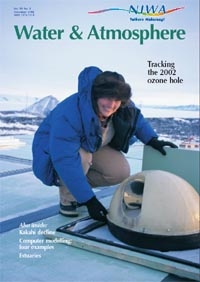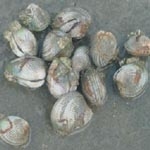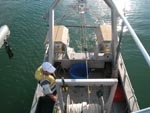PDF of this article (502 KB)

Judi Hewitt
Research is underway to pin down the effects of increasing sediment inputs to coastal waters on some of New Zealand’s important shellfish species.



In New Zealand, changes in land use (such as deforestation and urbanisation), and modification of coastlines have increased sediment build-up in coastal environments. Suspended sediment concentrations in estuaries and along the coasts can increase by orders of magnitude for hours to several days following erosion during storms. In big storms, a large proportion of the annual sediment load may be delivered in a matter of hours. Because of processes that cause sediment to go back into suspension – like waves, currents, animals digging in the sediment – suspended sediment levels are often highest in bottom waters.
In estuaries and coastal embayments, most shellfish consumed by people (oysters, mussels, cockles and pipis) are suspension feeders. They often make up a large proportion of the animals that live in and on the seabed in these places and affect exchanges between the water column and the seabed (such as nutrients and sediment). As these animals feed by removing particles from the water, they are likely to be directly impacted by changes to suspended sediment. It is important to be able to predict any negative effects on suspension feeders caused by such changes.
Effects of extra sediment
Effects of elevated suspended sediment depend primarily on two factors: the size range of the sediment particles, and the food content of the suspended sediment.
If the changes to sediment involve particles above the maximum size used by most suspension feeders (about 20 mm diameter) then effects will probably be minimal.
If the food content in sediment increases, animals may be able to get more nutrition for time spent feeding. If the food content decreases, animals will have to work harder for their food. The more energy they have to spend to gain the same amount/quality of food, the less energy they have for growth and reproduction. As the energy used on feeding increases, the animal loses condition and, finally, dies.
Scientists have investigated feeding rates of suspension-feeding bivalves for many years. Most of the species studied are those that are commercially and recreationally important overseas. Water temperature, velocity, particle size and suspended sediment concentrations, and food quality have all been found to affect feeding rates. Similar factors are likely to be important for New Zealand species, though differences in feeding morphologies, behaviour, feeding methods, energy uptake rates and metabolic costs mean that we cannot transfer the results directly.
Study species
NIWA scientists are investigating the relationship between increased suspended sediment concentrations and the ingestion, growth rates and condition of a number of suspension-feeding shellfish. So far work has concentrated on the horse mussel (Atrina zelandica), the cockle (Austrovenus stutchburyi), and the pipi (Paphies australis).
Horse mussels are large (up to 30 cm long) and live in many coastal areas of New Zealand in depths ranging from shallow subtidal to about 50 metres. Cockles are the most common intertidal bivalves found in New Zealand, and frequently occur in very dense beds. Adult pipis are generally found in low intertidal areas, near channels with fast flows, and are generally 6–10 cm long.
The answers so far
Although our studies are still in progress, we have found adverse effects of increased suspended sediment concentrations on each of these species. For example, consistently negative effects were found on the growth and condition of horse mussels, the growth of cockles, and the condition and reproductive output of pipis. Feeding rates of all species initially increased, but as suspended sediment continued to increase, feeding rates decreased. Condition of cockles showed a similar result, with peak condition occurring at suspended- sediment levels around 400 mg/litre. Some of our research also suggests that the response to increases will depend on the reproductive state of the animal and whether they live in areas with frequent high suspended-sediment concentrations.
We will continue to investigate effects on suspension-feeding shellfish, broadening the number of species investigated. However, other types of animals may also be affected by increased suspended-sediment concentrations. The increased flux of sediment settling on the seabed is likely to affect animals that feed on deposited sediment. Lower water clarity may affect the quantity, type and depth to which bottom-living microscopic algae and seaweeds can grow, thus affecting feeding and distributions of grazers (such as paua). Lower water clarity may also affect feeding abilities of visual predators (such as snapper). New studies will investigate the effects for these types of animals.
Teachers: this article can be used for Biology L7 A.O. 7.1a. See other curriculum connections at www.niwa.co.nz/pubs/wa/resources
Judi Hewitt is based at NIWA in Hamilton.
This work was carried out in the FRST programme "Effects of sediment on estuarine and coastal ecosystems" (contract C01X0024)
